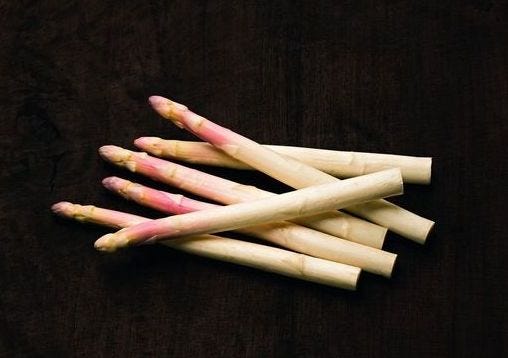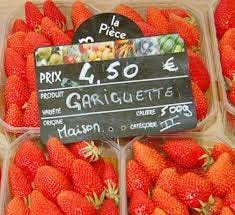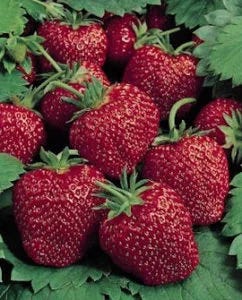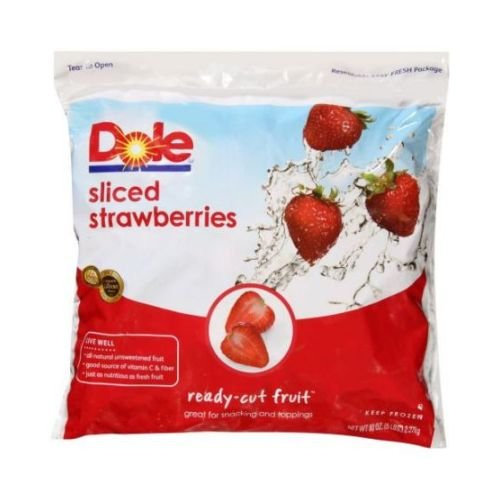To everything there is a season: NOW is the time for strawbugs and sparrowgrass
How to improve imported strawberries and asparagus, if you really must buy them

On a flight out of Boston this week, I watched a passenger dig into a fruit carton he’d bought on the airport concourse. There were mango tongues, watermelon grins, and a strawberry the size of a tennis ball. It took him seven bites to consume it, champing into it with the sound of a horse ripping grass off a tussock. Not a single drip of juice sullied his chin.
This is not how a strawberry should be.
There may be some out there who believe that strawberries are a year-round fruit, and asparagus a 12-month vegetable. Nope. Only now are we about to plunge into strawberry season. June is when they come naturally into their own. Same for asparagus. And just like asparagus, the out-of-season strawberries come from overseas - asparagus from Peru, the strawberries sold in Britain from Spain, and in the US from Mexico.
These interlopers have very little in common with the asparagus and the strawberries grown in fields in Britain, in Europe and on small farms in the USA. Peruvian asparagus comes to us courtesy of thousands of carbon-emission air miles. Its price is kept low because it has been harvested by people bent over double all day long who aren't paid a legitimate wage. It is grown in reclaimed desert, so depends upon heavy watering to develop.
Neither strawberries nor asparagus come anywhere close in flavour to the asparagus and strawberries grown in Britain or France and Italy, and for sale in season in American farmers’ markets. These are not supermarket-conforming - uniform in size and colour. Perversely, Nature tends to grow its bounty in wayward shapes and shades. According to supermarkets, that’s not how we consumers want them. Really? How much joy did that red missile give my flying companion?

Local seasonal strawberries are highly scented - in the nose and to the taste buds, and so juicy that extreme care is essential if you're eating them straight off the hull. Strawberries that have racked up flyer miles have the texture and taste of radishes but without the pepperiness of those little roots, while asparagus from Peru has none of the grassiness associated with asparagus grown in beds so much closer to home.
Locally grown strawberries and asparagus are coming into Britain's shop around now. But in France, the asparagus season which lasts only a few short weeks in farmers’ markets, is almost over. Housewives will not be buying it again until this time next year.
In France, asparagus comes in thoroughly esoteric types, some of which have been awarded IGP status - Guarantee of Control and Certification, the certificate which recognises an agricultural product for its quality or reputation, and which links to its geographical origin.
The most common variety is Belle d'Argenteuil, grown in Île-de-France, the area around Paris. It’s a little bitter in taste and with a white lilac-tipped stalk. Green asparagus grows entirely in the sun and open air but white asparagus is grown like leeks, the soil mounded up to hide it from the sun, or even underground. Another white variety is Landes asparagus, from the Landes de Gascogne, the region along the Atlantic beyond Bordeaux in southwest France, awarded its IGP status in 2005. Camargue asparagus, also white, is grown in tiny quantities in southern France between the Mediterranean and the delta of the Rhône river. It is treasured for the flavour produced by the saltiness of the sandy soil from the sea marshes, mounded up around the stalks. Blayais asparagus, anointed with IGP status in 2015, is a white or purple asparagus picked on small family farms north of the Gironde river in south-west France from the end of February until the end of May.
Purple asparagus, which has 20 percent more sugar than the green and the white, grows in full sun. It was originally developed by farmers in Italy's Albenga region and now grows happily in warm regions of the US and across Europe. Add lemon juice or a splash of vinegar when cooking it, to preserve its colour which is produced by anthocyanin, a pigment responsible for the red, purple and blue in fruits and vegetables.
So: how does your supermarket’s imported Peruvian asparagus stand up to all of that glory?
Twenty years ago, you would never have found any asparagus from Peru. Now the country has become the largest exporter of fresh asparagus, producing twice as much per hectare as its competitors and exporting 99 percent of it. Only 1 percent is held back for its own population to eat, none of whom is likely to be its picker. Grown in irrigated beds planted in reclaimed desert, it is forced into dormancy by turning off the water to bring back the region’s natural drought conditions. This way, production can be manipulated year-round to meet overseas demand.
Its high yield and Peru's low labour and water costs have turned asparagus into a cheap vegetable to produce. Unable to compete, some US growers went out of business, and government compensation was put in place to support them.
Where the US needs no financial assistance is with strawberries. It is the world's No. 1 producer followed by Spain, whose market, worth €400 million and underpinning 50,000 jobs, stretches right across Europe. Grown in Spain’s southwest Huelva region, 90 percent is exported. The plants go into the ground in October in long plastic poly-tunnels, for harvesting from January to June. That ground is the same land year after year, with no rotation with other crops. As a consequence, the depleted soil is infested with nematodes and pathogens that infect the plants. To eliminate them, the soil is treated with fumigants then covered in plastic sheeting and the strawberry plants dug in through slits in the plastic. It’s a similar system in California, where plants, produced in open fields, are ‘fertigated’ - drip-fed fertilizer through a tape running underneath the strawberries.
Along with asparagus, the French have elevated strawberries to a celestial level. In the Périgord in south-west France, seven varieties have been granted IGP status, each one taking over from the last as the season progresses. French women don't just set out with 'Strawberries' on their shopping lists. They buy them for specific use, seeking out different varieties for different recipes. One kind may be best for jam while another shines in a cooked tart and yet another is simply for eating with sugar and perhaps a little Crème Chantilly. None of them is designed for in-flight flamboyance.
Gariguette, with its long as opposed to round berry, is one of France's most popular strawberries. Grown primarily under shelter, it's the first to arrive on market stalls in late March and remains in season until early July when other varieties take over. Recently, Gariguettes have begun to penetrate British high-end food stores.
Mara des Bois, one of the two most famous IGP strawberries (Gariguette is the other) was developed, as its name indicates, to reproduce the flavour of tiny wild woodland strawberries in a garden-sized fruit. Dark red, it is prized for its highly scented taste.
Arabella is a bright red strawberry, firm, juicy and sweet but with an acidic edge, making it a popular variety for jam.
Charlotte, with a season running from early summer to the first frost, is a fruity, soft-fleshed strawberry preferred by some to Arabella for jam making because of the way it collapses more in the cooking process.
If you can't go to France or to farmers' markets in the UK and the US for your asparagus and strawberries, do your best to wait until their natural growing season. Then perhaps Peruvians might be persuaded to use their reclaimed desert to service their own population's food needs, and industrial soft fruit growers might consider turning over their exhausted soil to a rotation of crops to be harvested in season. We consumers do have a voice.
But if your strawberries are faltering in flavour, take a quarter of the quantity you’ve bought. Sugar them to taste and blitz them with a copious amount of lemon juice (juice of one lemon or more to 500g/½ lb) then pour the sauce (sieved to remove most of the pips) over fruit you have halved. It will raise seasonal as well as imported strawberries to an even higher level.
If you’re lucky enough to live near a supply of Morecombe Bay shrimps or crevettes grises, known as brown shrimp, this is a splendid warm asparagus salad. You can substitute successfully with small prawns chopped in three. Whatever you do with your asparagus, the best way to remove their chewy ends is to bend the stalks, holding them at the woody end until they naturally snap at the point where they become fibrous.
600g/21oz asparagus spears
50g/3½ tablespoons butter, plus 1 tablespoon
1 unwaxed lemon
Pinch of mace
200g/7oz brown shrimps (substitute small prawns or shrimp)
40g/1½ oz breadcrumbs
Bring a pan half full of salted water to the boil. Bend the asparagus holding them at the woody end until they naturally snap at the point where they become chewy.
Melt the butter in a frying pan until melted and beginning to turn amber, then lower the heat right down. Grate in the zest of the lemon and stir in a squeeze of its juice along with the mace. Stir in the shrimps and leave to warm through or, if using prawns, till they are opaque.
Melt the remaining tablespoon of butter in a small frying pan over a medium high heat, then toss the breadcrumbs until golden. Season well.
Put the asparagus in the pan of boiling water, tips sticking out of the top of the water, cover and cook for about 5 minutes until just tender (the exact time will depend on the width of the stalks, so keep checking).
Drain well, and then toss in the shrimp butter. Divide between serving plates and top with the breadcrumbs.









Thank you for teaching me all about Strawberries here in France. Must go to market for some Gariguettes tomorrow. Avec some sugar and crème chantilly.
I loved this article. It reminded me of my childhood, picking strawberries at my grandfather’s little farm in upstate NY. We ate as many as we picked. Everything was organic, well before organics were a niche market. I bought some at our local farmers’ market last weekend which were tiny & delicious. I also bought a bunch of very large, dark green asparagus which tasted nothing like asparagus from the supermarket. Thanks for writing this.